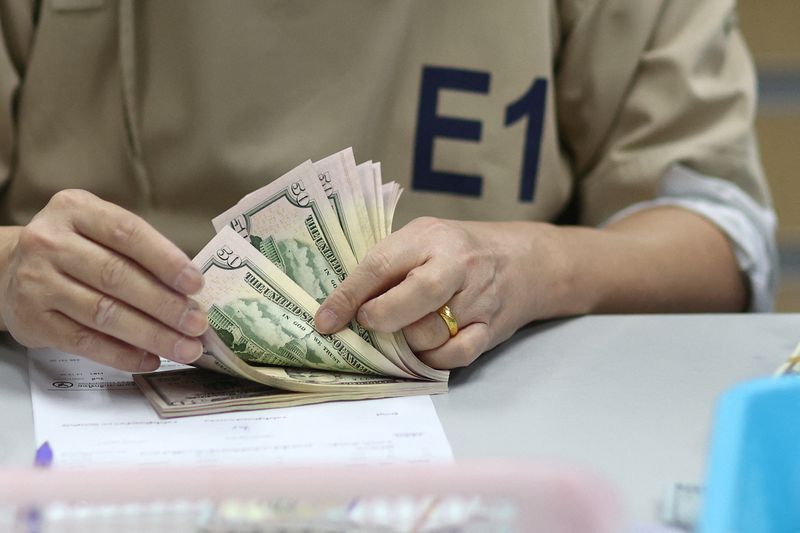Forex
Yen jumps and dollar slips as traders eye interest rate tweaks


© Reuters. A bank employee counts U.S. dollar notes at a Kasikornbank in Bangkok, Thailand, January 26, 2023. REUTERS/Athit Perawongmetha/File Photo
By Harry Robertson and Tom Westbrook
LONDON/SINGAPORE (Reuters) – The yen rallied against the dollar for a fourth straight session on Tuesday as investors positioned for the possibility that the Bank of Japan will tighten monetary policy next year while the U.S. Federal Reserve loosens.
Also weighing on the dollar and boosting the yen was a rally in China’s yuan, which rose to an almost four-month high.
The dollar hit its lowest level since mid-September at 147.16 yen and was last down 0.53% at 147.6.
More broadly, the , a gauge of the greenback against six other currencies, fell to its lowest since late August at 103.17 and was last 0.13% weaker at 103.32.
“There has been a lot of excitement, momentum is building, about the ability of the Bank of Japan to exit its ultra-loose monetary policy… possibly next year, ending negative interest rates,” said Jane Foley, head of FX strategy at Rabobank.
Foley said a sharp drop in the dollar was also encouraging investors to unwind some of their bets against the yen. “The dollar is weaker, and this I think is just the catalyst for the market making bets on how far dollar-yen can really move,” she said.
China’s yuan hit an almost four-month high of 7.13 per dollar and was last at 7.138.
The People’s Bank of China set the midpoint of the yuan’s trading band at its strongest since Aug. 7.
“We think the sizable rally in the is the primary driver of the stronger yen this week as it is lifting (Asian) FX as a whole,” said Simon Harvey, head of FX analysis at Monex Europe.
The euro rose to its highest since mid-August at $1.0966 on Tuesday and was last slightly higher at $1.0944.
Sterling was up 0.26% at $1.2538, after hitting a two-month high of $1.2554. Bank of England Governor Andrew Bailey on Monday said it was “far too early to be thinking about rate cuts” in Britain.
U.S. Treasury yields have tumbled as investors have wagered that the Federal Reserve will cut interest rates next year, after a slowdown in U.S. inflation in October.
That has dragged the dollar index down from an almost one-year high at the start of October, when U.S. economic data was consistently beating expectations.
The was on track to fall for a fourth session running on Tuesday to 4.39%, after dipping on Monday in the wake of a solid auction of 20-year bonds. It hit a 16-year high above 5% in October.
Elisabet Kopelman, U.S. economist at lender SEB, said: “Strong risk appetite and speculation about future interest rate cuts are not a good environment for the dollar.”
Minutes from the Fed’s last meeting are due at 1900 GMT and headline the day ahead, along with a speech from European Central Bank President Christine Lagarde.
Some analysts caution that the dollar’s downward momentum may not have too much further to run. “There is a risk that we are going to get push-back about the pace of Fed easing,” said Foley.

 Forex3 years ago
Forex3 years agoForex Today: the dollar is gaining strength amid gloomy sentiment at the start of the Fed’s week

 Forex3 years ago
Forex3 years agoUnbiased review of Pocket Option broker

 Forex3 years ago
Forex3 years agoDollar to pound sterling exchange rate today: Pound plummeted to its lowest since 1985

 Forex3 years ago
Forex3 years agoHow is the Australian dollar doing today?

 Cryptocurrency3 years ago
Cryptocurrency3 years agoWhat happened in the crypto market – current events today

 World3 years ago
World3 years agoWhy are modern video games an art form?

 Commodities3 years ago
Commodities3 years agoCopper continues to fall in price on expectations of lower demand in China

 Economy3 years ago
Economy3 years agoCrude oil tankers double in price due to EU anti-Russian sanctions





















